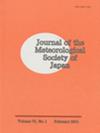云对向下长波通量的辐射贡献的变化
IF 1.6
4区 地球科学
Q3 METEOROLOGY & ATMOSPHERIC SCIENCES
引用次数: 1
摘要
云强烈影响向下的长波辐射通量,并影响地面的辐射收支。我们从绝对和相对两个方面评估了云辐射对地面向下长波辐射的影响;我们考虑了云辐射效应随云量、可降水量和云底高度变化的变化,这些变化由基线地面辐射网的8个站点测量。辐射传递模型预测的向下长波辐射与观测结果吻合较好。云辐射强迫和贡献分别在-21 ~ 92 wm - 2和- 6% ~ 38%之间。云效应与短波扩散指数(云量指标)呈正相关,与可降水量呈负相关。根据场地条件的不同,绝对效应值较小,但相对效应值在干燥条件下大于潮湿条件下。在潮湿条件下,短波扩散系数的影响很小。在干燥和寒冷的条件下,例如在极地地区,云辐射贡献的负值经常出现,因为云吸收逆温层的辐射。与先前使用a - train卫星产品的研究相比,本研究显示水汽量的云强迫分布更广,最大值更大。云效应与云底高度大致呈负相关关系,而位于日本太平洋一侧的馆野低云下与云底高度呈正相关。这种相关性是由于在夏季和冬季,馆野的云底高度和云效应之间存在不寻常的关系。这些结果描述了云效应的小尺度和近地表变化,这些变化很难通过卫星测量来检测。本文章由计算机程序翻译,如有差异,请以英文原文为准。
Variation in Radiative Contribution by Clouds to Downward Longwave Flux
Clouds strongly influence downward longwave radiative flux and affect the radiation budget at the surface. We evaluated the cloud radiative effect in both absolute and relative terms on downward longwave radiation at the surface; we considered variations in the cloud radiative effect with changes in cloud amount, precipitable water, and cloud base height, as measured by eight stations of the Baseline Surface Radiation Network. The downward longwave radiation predicted by a radiative transfer model agreed well with observations. The cloud radiative forcing and contribution ranged from –21 to 92 W m–2 and from –6 % to 38 %, respectively. The cloud effect shows a positive correlation to the shortwave diffusivity index (an index of cloud amount) and a negative correlation to precipitable water amount. The absolute effect values are small, depending on site conditions, but the relative effect values are larger under dry conditions than under humid conditions. Under humid conditions, the effect of the shortwave diffusivity index is very small. Under dry and cold conditions, such as those found in polar regions, negative values of cloud radiative contribution appear frequently because clouds absorb the emissions from temperature inversion layers. In comparison with prior research that used the A-Train satellite product, the present study shows a wider distribution and a larger maximum value for cloud forcing from amount of water vapor. Cloud effect has a roughly negative relationship with cloud base height, but a positive correlation with cloud base height occurs under low clouds at Tateno, which is located on the Pacific Ocean side of Japan. This correlation is because of the unusual relationship between cloud base height and cloud effect at Tateno during the summer and winter seasons. These results describe small-scale and near-surface variations in cloud effect, which are difficult to detect by satellite measurements.
求助全文
通过发布文献求助,成功后即可免费获取论文全文。
去求助
来源期刊
CiteScore
6.70
自引率
16.10%
发文量
56
审稿时长
3 months
期刊介绍:
JMSJ publishes Articles and Notes and Correspondence that report novel scientific discoveries or technical developments that advance understanding in meteorology and related sciences. The journal’s broad scope includes meteorological observations, modeling, data assimilation, analyses, global and regional climate research, satellite remote sensing, chemistry and transport, and dynamic meteorology including geophysical fluid dynamics. In particular, JMSJ welcomes papers related to Asian monsoons, climate and mesoscale models, and numerical weather forecasts. Insightful and well-structured original Review Articles that describe the advances and challenges in meteorology and related sciences are also welcome.

 求助内容:
求助内容: 应助结果提醒方式:
应助结果提醒方式:


